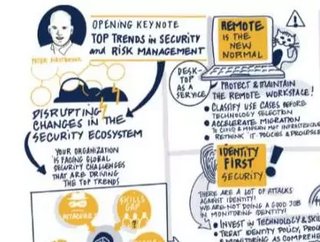Gartner: Top security and risk management trends 2021

The pandemic and acceleration of digital transformation along with other factors have led to an array of challenges facing security and risk leaders in 2021.
Among these are the rising skills gap, a complex geopolitical situation, increasing global regulations, migration of workspaces and workloads off traditional networks, an explosion in endpoint diversity and locations and a shifting attack environment, in particular, the challenges of randomware and business email compromise.
According to Peter Firstbrook, research VP at Gartner, who delivered the opening keynote at the Gartner Security & Risk Management Summit, which recently took place virtually in APAC, business leaders must address them in order to enable rapid reinvention of their organisation.
The following top eight trends represent business, market and technology dynamics that are expected to have broad industry impact and significant potential for disruption.
Trend 1: Cybersecurity mesh
Cybersecurity mesh is a modern security approach that consists of deploying controls where they are most needed. Rather than every security tool running in a silo, a cybersecurity mesh enables tools to interoperate by providing foundational security services and centralized policy management and orchestration. With many IT assets now outside traditional enterprise perimeters, a cybersecurity mesh architecture allows organizations to extend security controls to distributed assets.
Trend 2: Identity-first security
For many years, the vision of access for any user, anytime, and from anywhere (often referred to as 'identity as the new security perimeter') was an ideal. It has now become a reality due to technical and cultural shifts, coupled with a now majority remote workforce during COVID-19. Identity-first security puts identity at the center of security design and demands a major shift from traditional LAN edge design thinking.
“The SolarWinds attack demonstrated that we’re not doing a great job of managing and monitoring identities. While a lot of money and time has been spent on multifactor authentication, single sign-on and biometric authentication, very little has been spent on effective monitoring of authentication to spot attacks against this infrastructure,” says Firstbrook.
Trend 3: Security support for remote work here to stay
According to the 2021 Gartner CIO Agenda Survey, 64% of employees are now able to work from home. Gartner surveys indicate that at least 30-40% will continue to work from home post COVID-19. For many organizations, this shift requires a total reboot of policies and security tools suitable for the modern remote workspace. For example, endpoint protection services will need to move to cloud delivered services. Security leaders also need to revisit policies for data protection, disaster recovery and backup to make sure they still work for a remote environment.
Trend 4: Cyber-savvy board of directors
In the Gartner 2021 Board of Directors Survey, directors rated cybersecurity the second-highest source of risk for the enterprise after regulatory compliance. Large enterprises are now beginning to create a dedicated cybersecurity committee at the board level, led by a board member with security expertise or a third-party consultant.
Gartner predicts that by 2025, 40% of boards of directors will have a dedicated cybersecurity committee overseen by a qualified board member, up from less than 10% today.
Trend 5: Security vendor consolidation
Gartner’s 2020 CISO Effectiveness Survey found that 78% of CISOs have 16 or more tools in their cybersecurity vendor portfolio; 12% have 46 or more. The large number of security products in organizations increases complexity, integration costs and staffing requirements. In a recent Gartner survey, 80% of IT organizations said they plan to consolidate vendors over the next three years.
“CISOs are keen to consolidate the number of security products and vendors they must deal with,” said Mr. Firstbrook. “Having fewer security solutions can make it easier to properly configure them and respond to alerts, improving your security risk posture. However, buying a broader platform can have downsides in terms of cost and the time it takes to implement. We recommend focusing on TCO over time as a measure of success.”
Trend 6: Privacy-enhancing computation
Privacy-enhancing computation techniques are emerging that protect data while it’s being used — as opposed to while it’s at rest or in motion — to enable secure data processing, sharing, cross-border transfers and analytics, even in untrusted environments. Implementations are on the rise in fraud analysis, intelligence, data sharing, financial services (e.g. anti-money laundering), pharmaceuticals and healthcare.
Gartner predicts that by 2025, 50% of large organizations will adopt privacy-enhancing computation for processing data in untrusted environments or multiparty data analytics use cases.
Trend 7: Breach and attack simulation
Breach and attack simulation (BAS) tools are emerging to provide continuous defensive posture assessments, challenging the limited visibility provided by annual point assessments like penetration testing. When CISOs include BAS as a part of their regular security assessments, they can help their teams identify gaps in their security posture more effectively and prioritize security initiatives more efficiently.
Trend 8: Managing machine identities
Machine identity management aims to establish and manage trust in the identity of a machine interacting with other entities, such as devices, applications, cloud services or gateways. Increased numbers of nonhuman entities are now present in organizations, which means managing machine identities has become a vital part of the security strategy.






